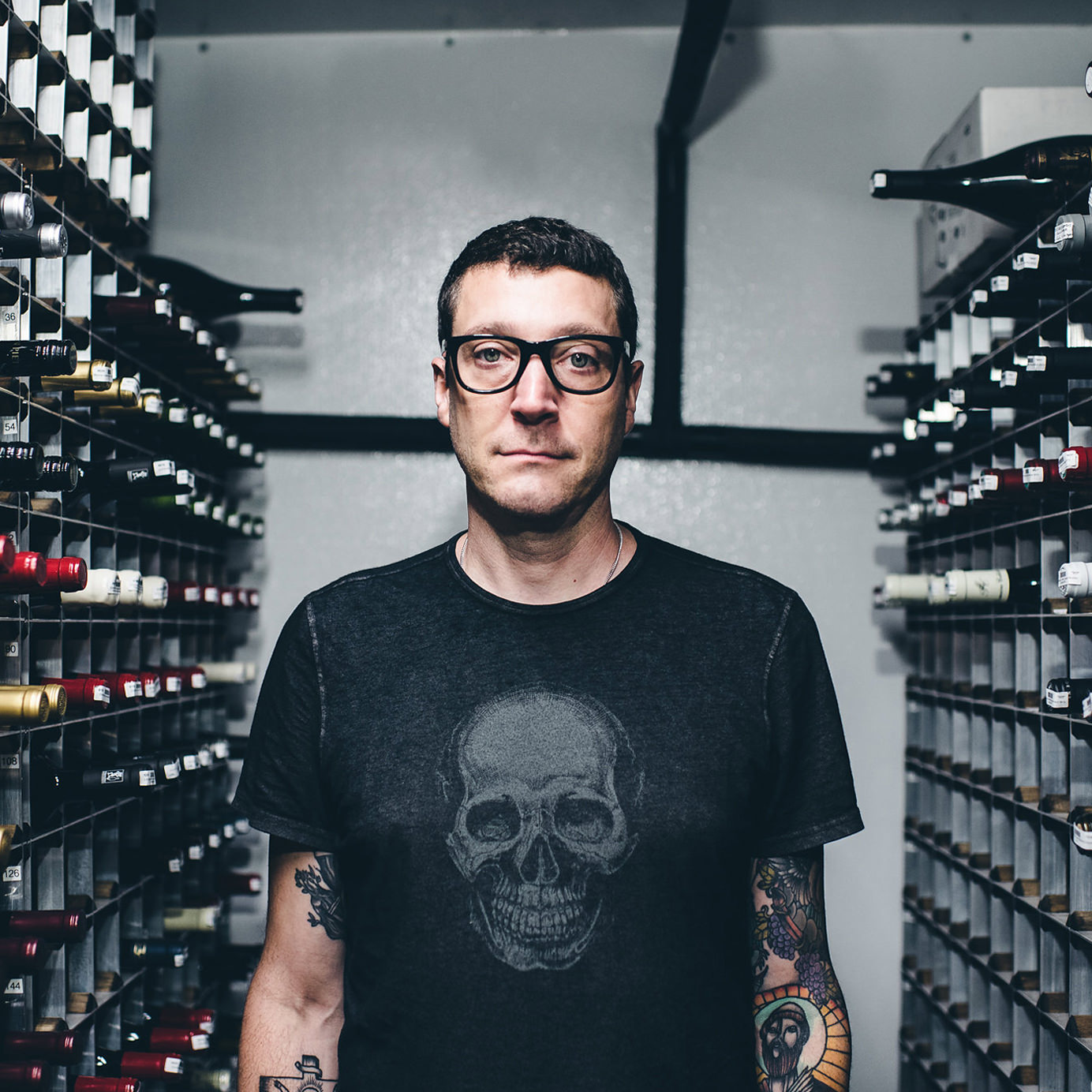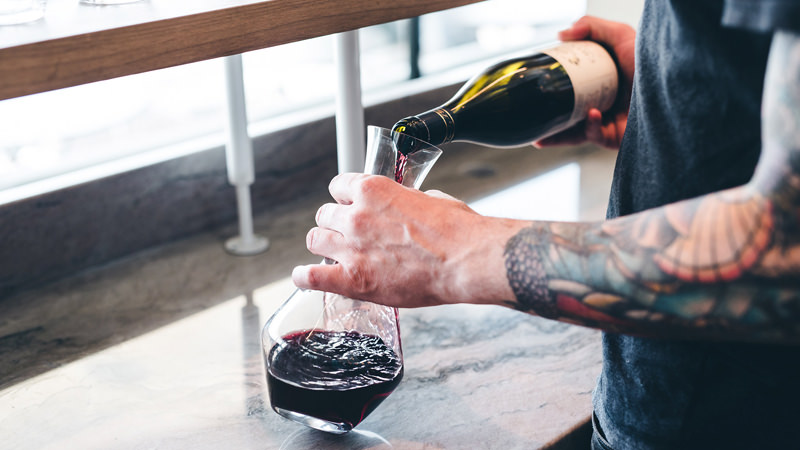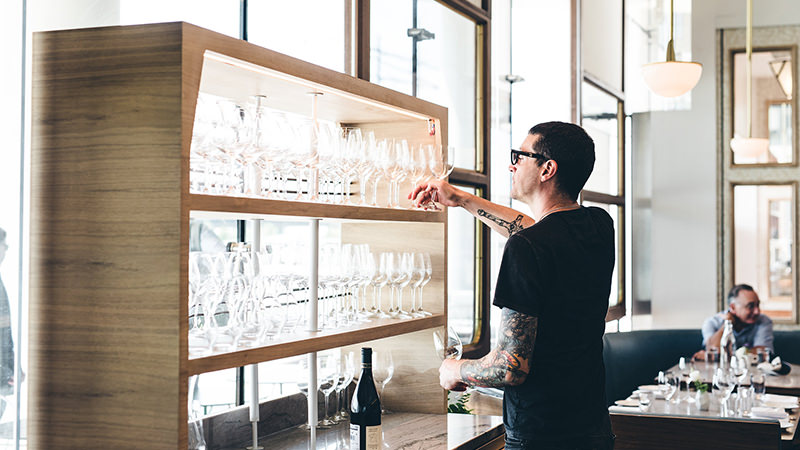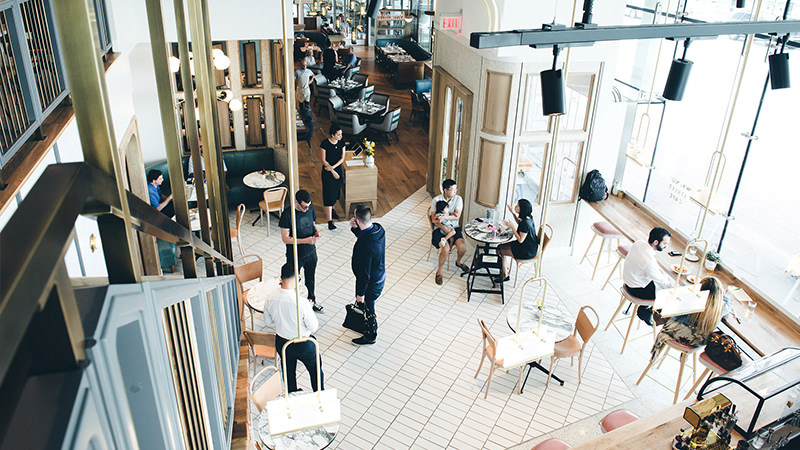The first thing I notice about Patrick Cappiello is how fast he talks. We’re sitting in Rebelle, his Michelin-starred restaurant on New York City’s Bowery, and I immediately have to ditch my notepad for the voice recorder on my phone. But when I consider the breadth and momentum of Cappiello’s career, this tempo makes perfect sense.
In addition to owning and operating Rebelle with Branden McRill and Daniel Eddy, Cappiello recently launched a wine brand, Forty Ounce Wines. The label packages high-quality French rosé and Muscadet in bottles that resemble classic beer forties. Unsurprisingly, Forty Ounce Wines quickly went viral and sold out. Named sommelier of the year by myriad publications and organizations, Cappiello has been known to sabor expensive Champagnes while standing atop his bar. He partnered with comedian Eric Wareheim to create a second wine brand, is considering reopening his incredibly successful Bowery wine bar Pearl & Ash in the West Village, and, as of June this year, splits his time between New York and his new apartment in Philadelphia, where he is opening a potentially game-changing new restaurant, Walnut St. Cafe.
It’s safe to say Cappiello is one of the most successful somms in the game right now and, to top it all off, he’s not even certified. This is a highly contentious issue among the food and beverage community, many of whom argue that sommelier certification is absolutely essential to success. Cappiello never even considered taking the exam.
I came to Rebelle to get to know Cappiello on the eve of another major challenge. Having revolutionized downtown Manhattan’s wine scene by celebrating accessibility and emerging styles, Cappiello was primed to translate his vision for the good people of Philadelphia — a city that, while geographically close to New York, has its own fiercely independent identity and what I’ll politely call trepidation about outsiders coming in and telling them what’s what. I wanted to know how he could juggle so much so successfully, evading timeworn rules and celebrity somm pratfalls for modern, progressive savvy. Ultimately, I wanted to know: Who is this guy?
Originally from Rochester, New York, Cappiello doesn’t come from a family with a strong connection to wine. He credits his blue-collar background with initiating him to restaurant work and creating his enduring love of cheap beer. (Modello is his bottle of choice.)
“My family was blue collar, they’re hard-working people,” Cappiello tells me. “Wine wasn’t part of our day-to-day experience.”
After working as a bartender, server and cook at a Chili’s in upstate New York and fine dining restaurant in Cleveland, Ohio, his then-wife’s opera career brought him to New York City, where he secured a job at Tribeca Grill.
“One of the things I noticed early on was that the waiters who knew more about wine were able to sell fancier bottles and therefore make more money than me,” Cappiello says of this initial period. “I was a newlywed who was trying to succeed and learning about wine seemed to be a path toward success.”
At Tribeca Grill, Cappiello was introduced to wine director David Gordon, who gave the young waiter an ad hoc wine education. Cappiello would hang in the cellar between shifts, organizing and receiving bottles, and reading every single book Gordon recommended. Within a year, Gordon asked Cappiello if he was interested in becoming a sommelier. Prior to this, Tribeca Grill had waiters who were knowledgeable about wine, but no sommeliers working the floor.
Cappiello immediately said yes, and went on to work with some of New York City’s ascendant wine tastemakers, including Daniel Johnnes of Montrachet and Tim Kopec of Veritas.
“I was super lucky, I had these … mentors who were friends and who drove me to learn more and more,” Cappiello says. Yet at no time did those mentors push him down the path of certification.
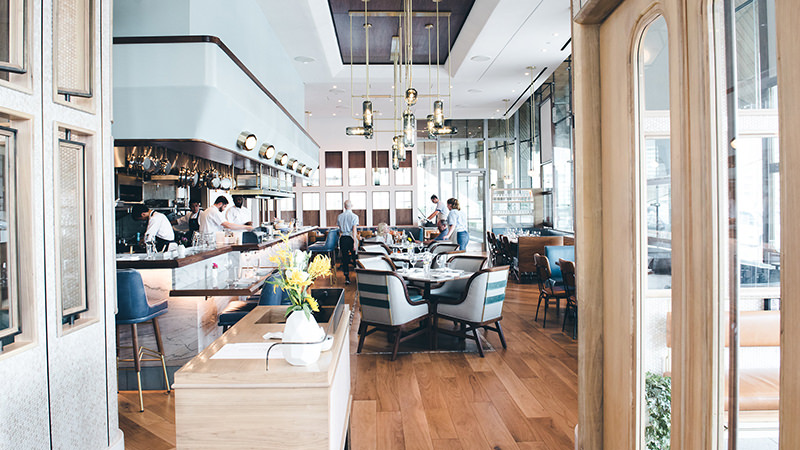
While serving as Wine Director at Gilt, Cappiello was buying expensive wines for the restaurant and affordable wines for himself. That’s when he first caught the bug for the sorts of cult categories — the Loire Valley, Beaujolais, the Jura, and natural wines — that would ultimately earn him a following among New York City wine geeks.
“You become jaded when you work at places like Veritas or Gilt because you’re drinking all this great Burgundy and Bordeaux with age on it, but when you go home, you’re not drinking that, you have to figure out other stuff to drink,” Cappiello explains. “I was trying to figure out other wines that had interest. What’s the next great value that also has terroir and really interesting history? The Loire Valley for me was that thing.” He brought this love for those wines with him when he finally went off on his own and opened his celebrated wine bar Pearl & Ash in February 2013.
These days, Loire Valley Cabernet Franc and Chenin Blanc have become so ubiquitously trendy that it’s hard to image a time when they were out of fashion. When I tell Cappiello that most young somms or wine shop staffers namecheck Chenin Blanc and Cab Franc when I ask about their favorite bottles, he chuckles. And he’s humble about his legacy, mentioning other influential wine professionals like Pascaline Lepeltier and Levi Dalton. But there is no denying that a lot of the reason we’re drinking the way we do now, particularly in New York, is because of Patrick Cappiello. “I think I’m at least partly responsible for the reason Clos Rougeard is now so expensive,” he says with a smile about the cult Loire Valley Cab Franc.
A month has passed since I caught up with Cappiello on the Bowery. I’m fresh from Philly’s labyrinthine Amtrak station, and finally standing in the middle of Walnut St. Cafe, Cappiello’s latest venture in University City. Located in a new high-rise, and humming with fresh energy, Walnut St. Cafe is poised to recreate that Rebelle and Pearl & Ash magic on the banks of the Schuylkill.
What made Pearl & Ash so revolutionary was its approach. When it opened, most somm-driven New York City enterprises were either classicists, pouring the veritable big game of the Old World, or self-styled rebels pouring esoteric bottles bound to intimidate those outside of the industry. Cappiello blended the two.
“People have asked about the programs I create: Why do you have all these really cool wines and still have wines from Bordeaux and Burgundy?” he says. “My answer is because all these wines are good and there is a clientele for each of them. I want people who enjoy more classic regions to feel just as comfortable here as the people looking for the newest, hippest bottle.”
Delivering this progressive philosophy to Philadelphia’s restaurant scene has its own set of challenges. The city has vast and influential beer cultures, but wine here is considerably less fractious than in New York. There are no old-versus-new hierarchies to dismantle. In fact, due to archaic statewide liquor laws, many of the bottles Cappiello plans to pour aren’t readily available to most consumers. Chances are Walnut St. Cafe will be Philadelphians’ first point of contact with many of the bottles on Cappiello’s list.
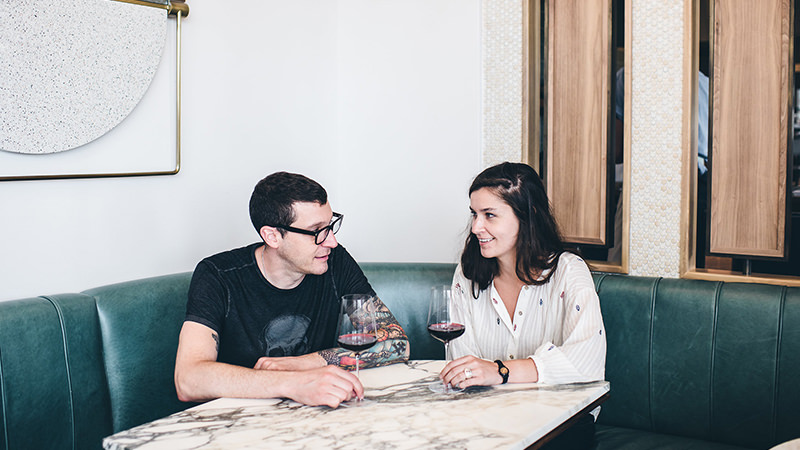
I ask Cappiello if he’s nervous about being seen as an outsider coming to Philly to build wine culture.
“We thought a lot about that before agreeing to open a place here,” he says. “It’s a big reason why we all got [apartments] here … We want to be a part of the Philadelphia scene, not just restaurateurs from another city who come in for the opening and then return in six months.”
In a nod to Philadelphia’s rich drinking culture, Cappiello offers a daily CityWide menu at the bar, many of which feature local beers and spirits. (“CityWide” is Philly-speak for a beer-and-shot combo.) He also offers 50 wines by the glass, since many of the bottles on his list are new to the state. It’s a welcoming approach, and one that his staff and clientele appreciate.
“Patrick is an incredible boss,” says Kaitlyn Caruke, a New York transplant who runs day-to-day operations for Walnut St. Cafe’s wine team and program. “He makes it so accessible and is so down to earth, it’s a pleasure to work with him.” Formerly at Rebelle, Caruke also happens to be an uncertified wine professional. I can’t help but wonder if Cappiello prefers those who learn by doing, as opposed to those who pursue certification.
“I value hard work,” Cappiello explains. “If for you hard work is translated through passing sommelier exams, I have incredible respect for that. Some of my best mentors and friends in this business are Master Somms. I honestly think the debate between whether you should be certified or not is stupid. Just do what you need to do to learn everything you can. If you have the knowledge, it will be proven on the floor. If you don’t, people will be able to tell really quick.”
It’s a chestnut that sticks with me long after I’ve boarded the Amtrak line back to New York. If you have wine knowledge and want to share it with others, what’s the point of debating how you did or didn’t come to learn so much? As the Philly skyline disappears through my window, I contemplate this elusive notion of “realness” in wine. Resisting wine snobbery is arguably the definitive characteristic of Cappiello’s impressive career. And I’d bet my train fare it’s going to make him and his team incredibly successful in the City of Brotherly Love.
